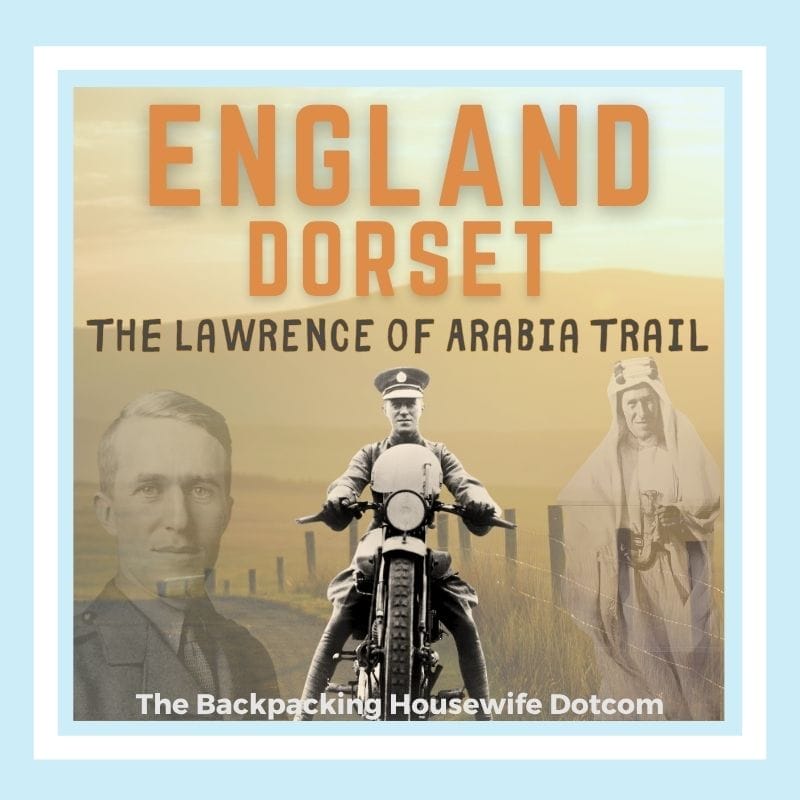Discovering T.E. Lawrence’s Dorset Hideaway
When you picture the Lawrence of Arabia Trail, you probably think of vast deserts, camel caravans, and windswept dunes.
But what if I told you that one of Britain’s greatest adventurers spent his final years seeking peace – not in the Middle East – but in the quiet rolling hills of Dorset in England?
On a recent trip to Dorset on the south coast of England, to my surprise, I inadvertently found myself on the Lawrence of Arabia Trail when I came across a small stone cottage called Clouds Hill.
The cottage had belonged to T.E. Lawrence (yes, that Lawrence)!
After leading Arab forces in the desert revolt during World War I, Lawrence became an instant legend – a diplomat, soldier, and a reluctant celebrity. But fame never sat easily with him and so in 1923 he bought the cottage and here he could swap his fame for quiet solitude, his desert robes for a leather jacket, and his camel for his beloved Brough Superior motorcycle.
He lived at Clouds Hill Cottage until his retirement and his untimely death in a motorcycle accident while riding his Brough Superior motorcycle in 1935.
Now cared for by the National Trust, the cottage remains almost exactly as he left it – sparse, intimate, and deeply personal.
There’s no electricity, and the rooms are filled with books, maps, and the scent of old wood smoke. Lawrence had called it his “earthly paradise.” I was immediately enchanted by the modest cottage in the midst of the breathtaking Dorset countryside, and I was suddenly curious about the man and the legend that is T.E Lawrence – or T.E Shaw – as he later preferred to be known while trying to preserve what was left of his fragile anonymity.
Address: Clouds Hill Cottage, Clouds Hill, Wareham, Dorset, BH20 7NQ

The Lawrence of Arabia Trail
TABLE OF CONTENTS
- Discovering T.E. Lawrence’s Dorset Hideaway
- The Lawrence of Arabia Trail
- St Martin on the Walls Church
- WAREHAM DORSET
- WHERE TO STAY IN WAREHAM DORSET
- ST NICHOLAS CHURCH MORETON
- WHERE TO STAY IN MORETON DORSET
- LAWRENCE OF ARABIA GRAVE
- THE MYSTERY OF THE WHITE ROSES
- WHO WAS LAWRENCE OF ARABIA?
- THE BROUGH SUPERIOR: LAWRENCE’S BELOVED MOTORCYCLE
- T. E. LAWRENCE’S DEATH – TRAGIC ACCIDENT OR BRUTAL MURDER?
- THE LAWRENCE OF ARABIA TRAIL IN DORSET
St Martin on the Walls Church
Later the same day, my interest in Lawrence’s life and death (1888-1935) was further piqued, when stopping off to explore the Dorset market town of Wareham, where I popped into the oldest church in Dorset – St Martin-on-the-Walls Church – which dates back to the early 11th century (1020) and was built during the reign of Saxon King Cnut (Canute).
Located on East Street, Wareham, from the outside, St Martin’s looks humble – a small stone building with a simple tower and a weathered charm – but the building is a remarkable survivor from England’s early medieval past.
Once inside, history seemed to echo from its thousand year old walls, and I marvelled at a rare 13th-century fresco on the north wall, a depiction of St Martin, alongside other original Saxon stonework.
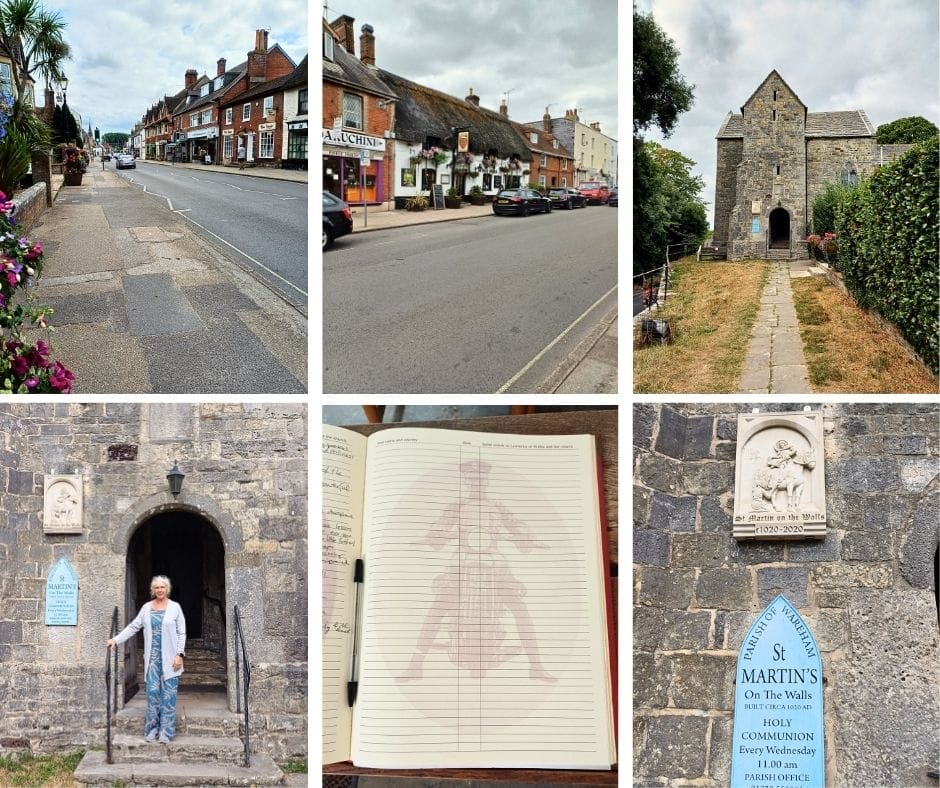
And, lo and behold, also here is a beautifully life sized carved effigy of T.E. Lawrence (Lawrence of Arabia!)
The effigy, installed here in September 1939, was sculptured by Lawrence’s friend, Erich Kennington from a three ton block of Portland stone.
A visitors book with an image of Lawrence astride his Brough Superior motorcycle invites comments and a handwritten poem by James Bramwell is on display next to the effigy.
It reads: This horizontal block of stone, Miraculously not a man, Is touched with presence nobler than The hollow scaffolding of bone. The chiselled tribute of a friend Who poured the harvest of his art, The stored up grains of a full heart To swell another’s plenteous end. He lies – so would a hero lie – At rest from being incomplete. When thirsting through life’s fevered heat Now bathed in cool eternity.
Immortally, Lawrence is depicted in Arab dress with the curved Jambiya dagger in his hand and a whip at his side. The Jambiya dagger was famously given to Lawrence by Sherif Nasir, Emir Feisal’s cousin, after the capture of Aqaba in July 1917.
Lawrence’s head rests on a camel’s saddle and beside his head are his favourite books – The Oxford Book of Verse, The Greek Anthology, and Mallory’s Morte D’Arthur. His feet rest against a block of Hittite sculpture of two bulls fighting, which represent both his archaeological research in the Near East and his own struggles with the Arab Campaign of the First World War.
Today, St Martin-on-the-Walls in Wareham is no longer used for regular worship but is lovingly cared for as a historic monument by the Churches Conservation Trust.
Address: St Martin-on-the-Walls Church. East Street, Wareham, Dorset BH20 4AD


WAREHAM DORSET
Following Lawrence’s footsteps through this part of Dorset – from his humble cottage to seeing his life size effigy displayed in the oldest church in Dorset – feels like I’m following a trail of clues to key places in an unwritten memoir that reveals his story!
I later learned that Lawrence would often pop into the nearby town Wareham on his motorcycle and meet with writer friends including Thomas Hardy in the ‘Anglebury Pub’ (now a hotel and restaurant).
Wareham is a charming town, with its riverside setting on the River Frome, it offers peaceful walks, boat trips, and easy access to the Isle of Purbeck and Jurassic Coast. Once a strategic stronghold, its ancient earth ramparts still encircle the town, among the best-preserved Saxon defences in England. These days, with its cobbled streets, cozy pubs, tea shops set in Georgian buildings, independent shops and lively Saturday market, Wareham has a timeless feel.
USE MY INTERACTIVE MAP TO FIND YOUR PERFECT PLACE TO STAY IN WAREHAM
Also in Wareham there is a Town Museum displaying items of Saxon and Roman Heritage AND an entire display with lots of photographs and exhibits for T.E Lawrence!
I’m amazed – in a totally unintentional way – I’m back on the Lawrence of Arabia Trail again!
The Wareham Town Museum is essentially a T E Lawrence museum and explores Lawrence’s early life – Lawrence the Archaeologist – Lawrence and The Arab Revolt – The Post War Years – and A Reconstruction of The Scene of The Accident. There’s even a life sized cardboard image of the man himself in his Arabian gowns!
There’s also a copy of The Seven Pillars of Wisdom (published in 1926) here in a glass case together with a small suitcase said to have belonged to him. There are lots of photos to see and newspaper cuttings to read that are mounted in frames.
Address: Wareham Town, Dorset, South West England. BH20. 50.686°N 2.1099°W
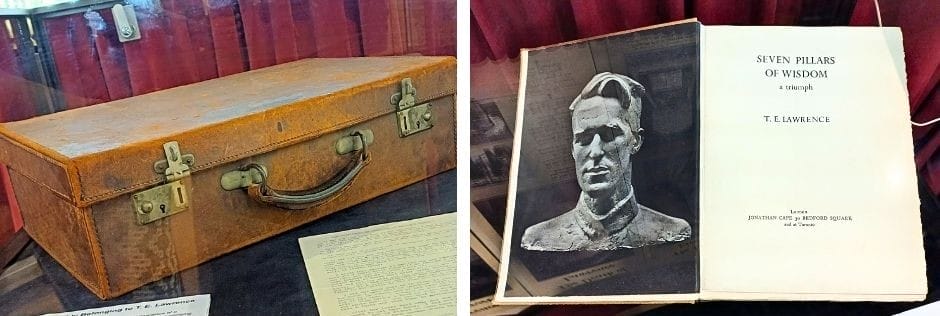
Following Lawrence’s footsteps through this part of Dorset – from his humble cottage, to seeing his life story displayed on the walls of the town’s museum – feels like I’m following a trail of clues to key places in an unwritten memoir that reveals his story!
The Lawrence of Arabia Trail
ST NICHOLAS CHURCH MORETON
The next stop on my Lawrence of Arabia Trail, is to visit St Nicholas Church in Moreton and to pay my respects to T.E Lawrence at his graveside.
St Nicholas Church dates from 1776 but in 1940, the church was largely destroyed by a German bomb. The church was rebuilt after the war but the windows were replaced with plain glass.
But in 1955, another Lawrence – Lawrence Whistler – was commissioned to engrave the thirteen plain windows in the church.
The work took thirty years and is the only example of its kind in the world and now St Nicholas in Moreton is renowned for its unique windows and visitors come from far and wide to see them.
Whistler engraved both sides of the glass to create the three dimensional ethereal effect and each window has an intricate and individual theme. I particularly admired The Four Seasons Window (1974) and the Galaxy Window which is above the west door (1984) with its spiral galaxies and stars turning into flowers, space walkers, chromosomes and sheaves of corn.
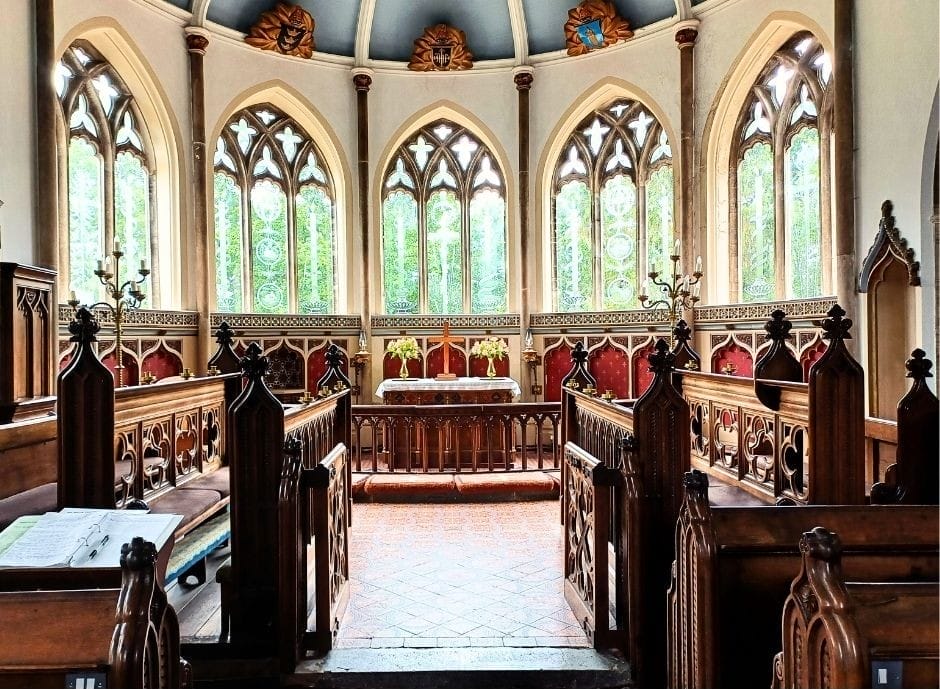
My favourite window – I called it ‘the widow window’ – is also known as the Trinity Chapel Window (1982). It is engraved in memory of an RAF pilot who died in a dogfight while flying his Spitfire over France and as remembered by his heartbroken young widow.
I had a lump of emotion in my throat at viewing the delicately engraved images of the pilot’s view of their home, of Salisbury Cathedral near to his training base, and the tangled wreckage of his plane just visible in one corner, and the dates of their short marriage from 1939 to1940.
Whistler’s controversial final, thirteenth window, on the theme of ‘Forgiveness’ is also called the ‘Judas’ window. The window design was so contentious that the window was not installed into the church until 2014 – fourteen years after Whistler’s death – and only on the proviso that the window is visible only from outside the church.
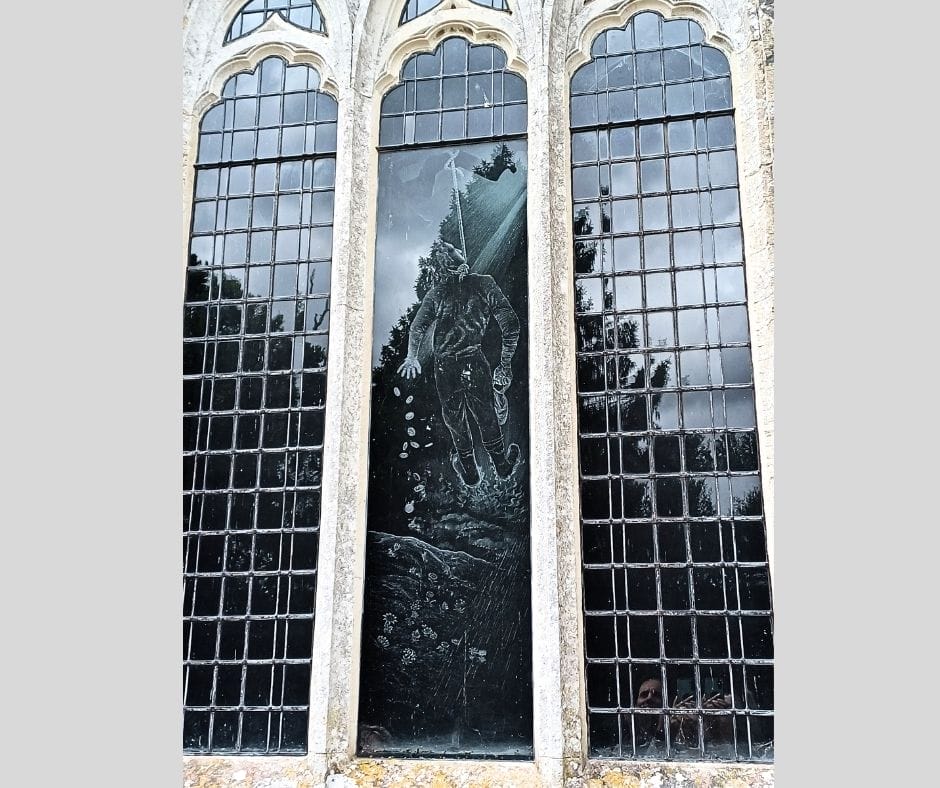
It is of a sinister image of Judas, the betrayer of Christ, portrayed as a figure hanging from the branch of a tree, coins spilling from his hand and turning into flowers as they reach the ground.
What a story – what an incredible church – I was mesmerised by those windows!
Address: Church of St Nicholas, Moreton, Dorset. DT2 8RH

LAWRENCE OF ARABIA GRAVE
But back to Lawrence of Arabia and the trail of T E Lawrence because here at St Nicholas Church in Moreton, on May 21st 1935, is where his funeral was held.
It was attended by many former comrades from his service days, soldiers, statesmen, and writers, and most notably Winston Churchill and Lady Nancy Astor. King George V sent a telegram of condolence.
In accordance with his wishes, attendees wore plain clothes and there were no flowers on the coffin. But there is a mystery still unsolved to this day about white roses placed on his grave!
THE MYSTERY OF THE WHITE ROSES
T E Lawrence’s modest grave – the final resting place of a man who lived larger than legend – draws visitors from around the world. Yet for decades, one tribute has stood out among all others – a yearly gift of white roses left in silence and secrecy.
The story begins around 1974, nearly forty years after Lawrence’s death, when on August 16th, his birthday, a bouquet of forty-six pure white roses appeared at his grave in Moreton Churchyard. One for each year of Lawrence’s life.
A single white rose was also left at the doorstep of his cottage at Clouds Hill.
In 1994, no bouquet had appeared that August. Yet, other visitors in later years claimed to have seen the flowers return, suggesting the ritual quietly continued into the early 2000s. Some say the flowers stopped with the death of the mysterious benefactor who was believed by many to be an American woman who had long admired Lawrence. But the identity of the admirer has never been confirmed. Over the years, theories have blossomed like the roses themselves.
The florist who handled the order maintained strict discretion, revealing only that the flowers were prepaid, delivered without fail, and never accompanied by a name or message. Whoever the sender was, they wanted no recognition, only to honour Lawrence in silence.
Today, the mystery of the white roses has become part of the folklore surrounding Lawrence’s life and death and visitors still leave flowers as if to keep the tradition alive in spirit.
I visited Lawrence’s grave on the 20th August this year – four days after his birthday – and as you can clearly see that just behind the vase of sunflowers in the photo I took below – there is a bouquet of white roses!
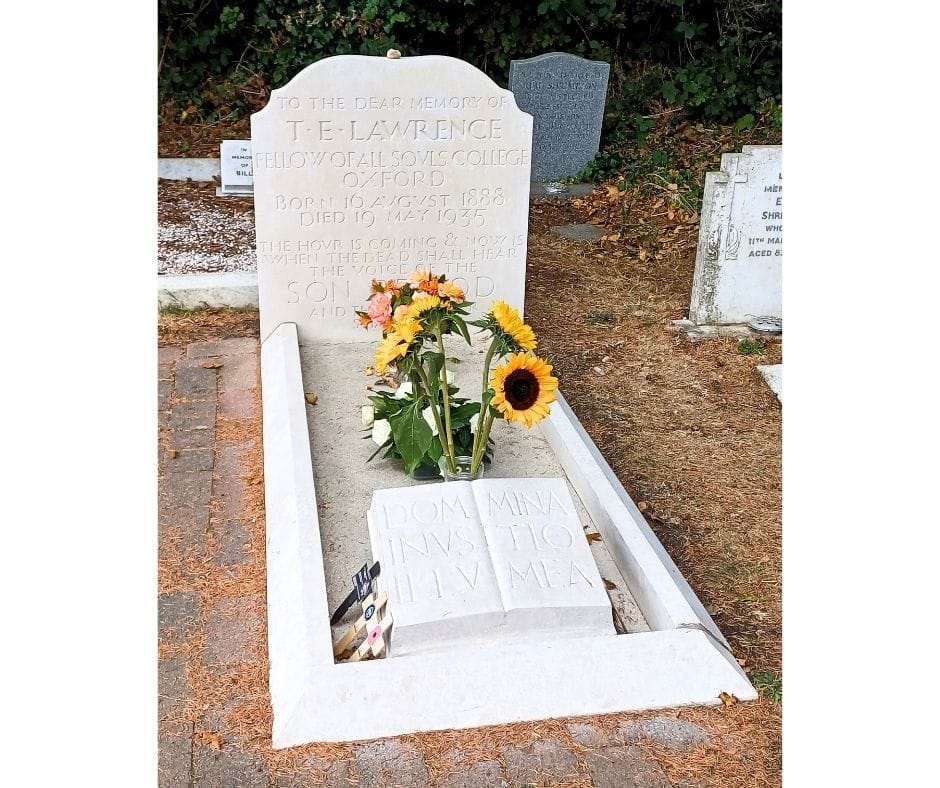
The place of burial and grave of T E Lawrence is in the adjacent annexed churchyard a little further down the lane from the Church of St Nicholas and in a quiet setting.
The inscription on his headstone reads: To the dear memory of T. E. Lawrence fellow of All Souls College Oxford. The hour is coming and now is when the dead shall hear the voice of the Son of God and they that hear shall live.
Address: St Nicholas Churchyard, Moreton, Dorset, England

WHO WAS LAWRENCE OF ARABIA?
Thomas Edward Lawrence was born in Caernarvonshire in North Wales in 1888. He was the illegitimate son of Thomas Chapman, an Irish aristocrat, and Sarah Maden, a governess.
Thomas and Sarah ran off together – which would have been a great scandal at the time – to various locations including France and Scotland having ‘adopted’ the new name of Lawrence.
Although they never married they went onto have five sons. T.E. was the second born son and he was known in the family as ‘Ned’. He grew up a keen reader of travel books.
From 1907 to 1910, he studied history at Jesus College, Oxford, and visited Arabia on archaeological expeditions. After graduating, he worked as an archaeologist at Carchemish in Syria from 1911 to 1914, a period where he learned to speak Arabic.
Aa a young man, he grew to despise the Turkish occupation of Arab lands. When war broke out, he was posted to the Arab Bureau in Cairo as an intelligence agent, tasked with promoting rebellion against the Ottoman Empire.
Forging a close relationship with Emir Faisal, he helped the Arabs carry out attacks on the Hejaz railway, which was the Turks only way of supplying Medina. In 1917, he arranged a successful operation to capture Port Aqaba.
Lawrence was awarded the Distinguished Service Order and after the First World War, from his legendary role in the Arab Revolt, he became one of the most famous men in the world. Yet he despised the spotlight and by the 1920s, he had withdrawn from public life, enlisting under assumed names in the RAF and Army. During this time he wrote a best-selling memoir ‘Seven Pillars of Wisdom’ (1926). In 1922 he joined the RAF as John Hulm Ross but his identity was discovered and uncovered that same year by the Daily Express.
He then took another new name, T E Shaw, and joined the Tank Corps at nearby Bovington.

THE BROUGH SUPERIOR: LAWRENCE’S BELOVED MOTORCYCLE
Between 1922 and 1935, Lawrence owned seven Brough Superiors – known as the Rolls-Royce of motorcycles – they were all custom-built by George Brough in Nottingham.
His final bike, Brough Superior SS100 motorcycle, was his pride and joy which he famously called his ‘steel horse’. On May 13, 1935, while riding near Clouds Hill, Lawrence swerved to avoid two cyclists and crashed. He died six days later, aged just 46.
The accident changed history. The surgeon who treated him, Hugh Cairns, went on to pioneer the use of motorcycle helmets, saving countless lives.
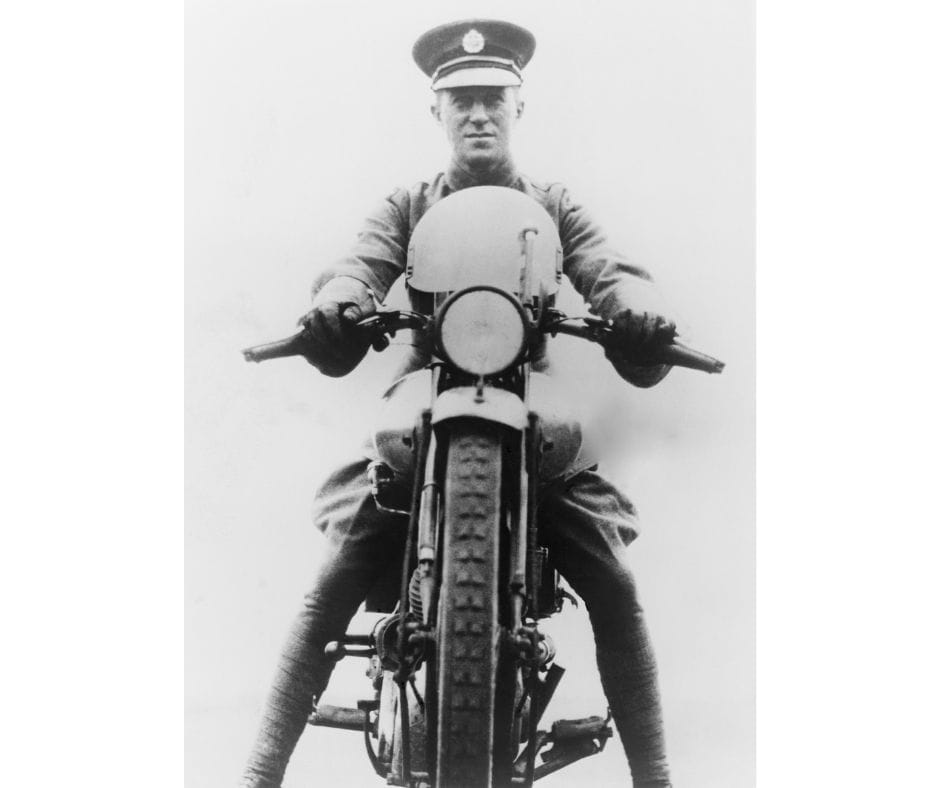
T. E. LAWRENCE’S DEATH – TRAGIC ACCIDENT OR BRUTAL MURDER?
Just recently, still fascinated by the inspirational and controversial life and times and death of T E Lawrence, in an effort to get to understand him better, I watched the 1962 movie Lawrence of Arabia starring Peter O’Toole.
I also watched the sequel A Dangerous Man: Lawrence after Arabia (1992) starring Ralph Fiennes as T.E. Lawrence and Alexander Siddig as Emir Faisal. There is also Lawrence: After Arabia (2020) which is based on a conspiracy theory that his death was not an accident but an assassination.
Both films shine an accusing light on those who, in 1935, might have considered the newly retired T E Lawrence as a dangerous man and at the very least a ‘loose cannon’. And those who perhaps had the motive, means, and opportunity to murder him and whom had the power to arrange a cover up in order to make his death look like a road traffic accident.
Examining the same theory, there is also the new feature length documentary (2024) Who Killed Lawrence of Arabia that similarly investigates the crash on 13th May 1935, which resulted in the death of T.E. Lawrence.
It seems there were many back then – with World War Two looming on the horizon – who had political reasons to want him out of the way and some who might have been worried about what was to be uncovered in his newly finished and yet unpublished book ‘The Mint‘ which describes his time in the RAF under an assumed name of Ross. It was published posthumously in 1955.

THE LAWRENCE OF ARABIA TRAIL IN DORSET
If you, like me, have found yourself both intrigued and fascinated by the life and the death of T. E Lawrence, I hope you’ve enjoyed following the trail of the desert hero who found his heaven in Dorset, and making a pilgrimage into the life of a man torn between adventure and peace. From the undulating dunes of Arabia to the rolling hills of Dorset, his story reminds us that sometimes the greatest journeys will lead us home.


